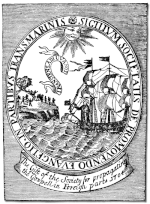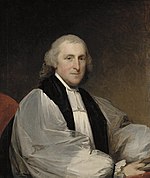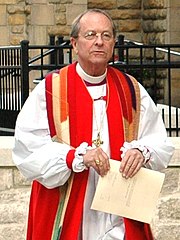History of the Episcopal Church (United States)
In the 1662 Preface, the editors note: ... that it was thought convenient, that some Prayers and Thanksgivings, fitted to special occasions, should be added in their due places; particularly for those at Sea, together with an office for the Baptism of such as are of Riper Years: which, although not so necessary when the former Book was compiled, ... is now become necessary, and may be always useful for the baptizing of Natives in our Plantations, and others converted to the Faith.In 1649, Parliament granted a charter to found a missionary organization called the "Society for the Propagation of the Gospel in New England" or the "New England Society", for short.With these funds, vestries controlled by local elites were able to build and operate churches as well as to conduct poor relief, maintain the roads, and other civic functions.The ministers were few, the glebes small, the salaries inadequate, and the people quite uninterested in religion, as the vestry became in effect a kind of local government.They appointed the parish ministers, made local assessments, and investigated cases of moral offense for referral to the county court, the next higher judicatory.In 1660, the clergy of Virginia petitioned for a bishop to be appointed to the colony; the proposal was vigorously opposed by powerful vestrymen, wealthy planters, who foresaw their interests being curtailed.[2] Opponents conjured up visions of "episcopal palaces, or pontifical revenues, of spiritual courts, and all the pomp, grandeur, luxury and regalia of an American Lambeth".[6] According to Patricia Bonomi, 'John Adams would later claim that "the apprehension of Episcopacy" contributed as much as any other cause to the American Revolution, capturing the attention "not only of the inquiring mind, but of the common people... .[8] Anglicans leaders realized, in the words of William Smith's 1762 report to the Bishop of London that, "The Church is the firmest Basis of Monarchy and the English Constitution.[7]: 201 More than any other denomination, the American Revolution divided both clergy and laity of the Church of England in America, and opinions covered a wide spectrum of political views: Patriots, conciliators, and Loyalists.[9] The second oath arose out of the Act of Uniformity of 1662 where clergy were bound to use the official liturgy as found in the Book of Common Prayer and to read it verbatim.[9] Charles Inglis, rector of Trinity Church in New York, persisted in reading the royal prayers even when George Washington was seated in his congregation and a Patriot militia company stood by observing the service.The fight over the sale of the glebes, or church lands, demonstrated the strength of certain Protestant groups in the political arena when united for a course of action.[11] When peace returned in 1783, with the ratification of the new Treaty of Paris by the Confederation Congress meeting in Annapolis, Maryland, about 80,000 Loyalists (15 percent of the then American population) went into exile.In the wake of the Revolution, American Episcopalians faced the task of preserving a hierarchical church structure in a society infused with republican values.The next day the first ordinations on American soil took place when Henry Van Dyke, Philo Shelton, Ashbel Baldwin, and Colin Ferguson were ordained deacons.This third American bishop consecrated within the English line of succession occurred because of continuing unease within the Church of England over Seabury's nonjuring Scottish orders.[21] A mostly female labor force formed the backbone of the church's urban outreach providing health care, education, and economic assistance to the disabled and disadvantaged.[21] Spurred by American imperialism, the church expanded into Alaska, Cuba, Mexico, Brazil, Haiti, Honolulu, Puerto Rico, the Philippines, and the Panama Canal Zone.The modernization of the church has included both controversial and non-controversial moves related to racism, theology, worship, homosexuality, the ordination of women, the institution of marriage, and the adoption of a new prayer book, which can be dated to the General Convention of 1976.In 1991 the General Convention declared "the practice of racism is sin"[31] and in 2006 a unanimous House of Bishops endorsed Resolution A123 apologizing for complicity in the institution of slavery and silence over "Jim Crow" laws, segregation, and racial discrimination.Following upon years of discussion in the Episcopal Church and elsewhere, in 1976, the General Convention amended canon law to permit the ordination of women to the priesthood.The church court dismissed the charges on May 15, 1996, stating that "no clear doctrine"[39] prohibits ordaining a gay or lesbian person in a committed relationship.It also charged the Standing Commission on Liturgy and Music to develop theological and liturgical resources for same-sex blessings and report back to the General Convention in 2012.Jefferts Schori generated controversy when she voted to confirm openly gay Gene Robinson as a bishop and for allowing blessings of same-sex unions in her diocese of Nevada.[citation needed] In addition, eight American dioceses rejected her authority and asked Archbishop of Canterbury Rowan Williams to assign them another national leader.[51][52] This grouping, which reported at its founding that it represented approximately 100,000 Christians through its over 700 parishes, elected former Episcopal priest Robert Duncan as its primate.[62] On April 27, 2010, the Second Court of Appeals in Fort Worth heard oral argument on issues that may determine whether the litigation will be allowed to proceed at the trial level.[65] A lawsuit filed in 2003, settled in 2005, reopened in 2007 and decided 2009 with final appeals in 2010 awarded the name and diocesan property to those who remained in the Episcopal Church in Pittsburgh.[70] Other rulings in Colorado and California have ordered congregations that have voted to change their associations within the Anglican Communion to return their properties to the Episcopal Church.[71] On January 5, 2009, the California Supreme Court ruled that St. James Anglican Church in Newport Beach could not keep property held in the name of an Episcopal parish.







AnglicanismTheologyChristian theologyAnglican doctrineThirty-nine ArticlesBooks of HomiliesCaroline DivinesChicago–Lambeth QuadrilateralEpiscopal politySacramentsMinistryEucharistKing James VersionBook of Common PrayerLiturgical yearChurchmanshipCentralMonasticismSaintsJesus PrayerChristianityChristChristian ChurchFirst seven ecumenical councilsCeltic ChristianityAugustine of CanterburyMedieval cathedral architectureApostolic successionHenry VIIIEnglish ReformationThomas CranmerDissolution of the monasteriesChurch of EnglandEdward VIElizabeth IMatthew ParkerRichard HookerJames ICharles IWilliam LaudNonjuring schismLatitudinarianAnglo-CatholicismLiberalOxford MovementAnglican CommunionAnglican Communion historyArchbishop of CanterburyAnglican Communion Primates'MeetingsLambeth ConferenceBishopsAnglican Consultative CouncilEcumenismOrdination of womenWindsor ReportContinuing Anglican movementAnglican realignmentBartonville AgreementCongress of St. LouisNorth American Anglican ConferenceEpiscopal Churchpresidents of the United StatesList of United States Presidential religious affiliationsabolitionist movementSocial GospelProhibitionist movementmainline churchesRoman Catholic ChurchVatican IIFirst ChurchJamestown, VirginiaAmerican coloniesVirginia Company of Londonestablished churchVirginiaNew YorkMarylandSouth CarolinaNorth CarolinaGeorgiaChrist Church, PhiladelphiaBritish North AmericaSociety for the Propagation of the Gospel in New EnglandSociety for the Propagation of the Gospel in Foreign Partsparishesvestriespoor reliefglebesBishop of LondonEnglish Civil Warsuffragan bishopJohn AdamsSt. John's Episcopal ChurchRichmond, VirginiaSecond Virginia ConventionPatrick HenryGive me liberty or give me deathAmerican RevolutionrepublicanismPatriotsLoyalistsredcoatDeclaration of IndependenceThomas JeffersonWilliam PacaGeorge WytheGeorge WashingtonSamuel ProvoostContinental ArmyordinationAct of Uniformity of 1662Charles InglisTrinity Church, New Yorklay readersMorningEvening PrayerContinental CongressGlorious RevolutionBaptistsJames MadisonSamuel SeaburyTreaty of ParisConfederation CongressAnnapolis, MarylandCanada



